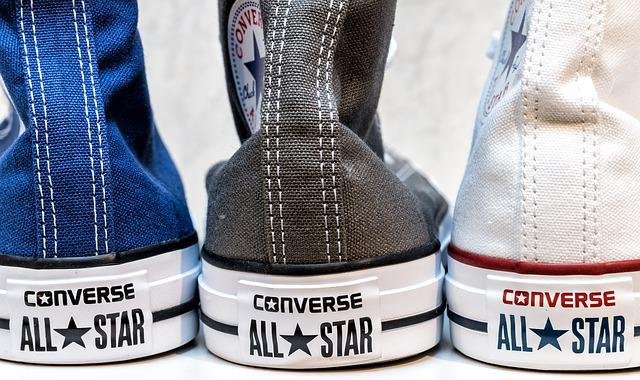Sneakers History: From Invention to High-Profit Industry

How did sneakers and trainers, grow from foot protectors to a high-profit industry? They are not being worn simply for comfort and protection but have paved the way for many underground cultural influences. Sneakers have become popular as a genre of culture through the interaction with music, sports and film. However, sneakers culture is controversial nowadays because of the market price around it, “ is the high-profit industry defined by cultural legacy or excessive price?”
SNEAKERS’ HISTORY BEGAN WITH THE INVENTION OF VULCANISED RUBBER
Early sneakers were developed through vulcanised rubber by Charles Goodyear in 1839. Vulcanised rubber, a process for hardening rubbers, uses heat and sulphur for more elasticity and strength. After this method, there was no progress made and this lasted a few decades. However, it was later found useful in the shoe industry as it was primarily worked for Plimsoll ( a type of athletic shoe with a canvas upper and rubber sole). Plimsolls quite were popular during the end of the 19th century and are called an ancestor of the sneakers.
SNEAKERS BRAND BORN IN THE EARLY 20TH CENTURY
Credit: Converse All-Star
Turning to the 20th century, sneaker brands that we are familiar with and still popular began its birth. In 1905, Gola was founded in England. In 1906, New Balance and Mizuno were founded in Boston and Osaka. In 1908, Converse and Keds were opened in the US in 1908 and 1916. Following previous Plimsoll rubber shoes, Converse and Keds released their sneakers in the same year, 1917. Converse produced the first shoe for basketball known as “Converse All-Stars” and the U.S. Rubber Company released the more comfortable rubber-sole sneakers with a canvas top called Keds.
Whilst, German brothers Adolf and Rudolf Dassler, founded Adidas and Puma. They created these sneakers for the 1936 Olympics and specifically for the runner Jesse Owen. He went on to win four gold medals with them. This was the starting point, as the sneakers became internationally known, sought after and most worn footwear among individuals.
SNEAKERS, BRIDGING CULTURES; SPORTS, FILM, MUSIC
Sneakers are now not just footwear; as they are closely knitted with sports stars, musicians and actors’ appearances, styles and lifestyles.
Being a symbol and stamp for certain eras and communities, sneakers are also the bridge for different genres or cultures connecting them all.
Sneakers’ popularity to the public mainly kicked off through their introduction into the sports field. Basketball player Chuck Taylor endorsed the Chuck Taylor All-Star in 1921 and it became the most popular and sold basketball shoes of all time and even it was the official sneakers of the NBA. Another iconic sneaker brand, “Air Jordan 1”, first debuted in the basketball endorsed shoe market in 1985. Michael Jordan whose silhouette was the inspiration behind the jump man logo affirmed that the Converse Chuck Taylor was his favourite shoe when he was in college. The jump man logo is called the ‘Wings’. Designer Peter Moore said the logo features a basketball with wings coming out from each side, as a metaphor for ‘Air’ Jordan. The inspiration for it came during an NBA All-Star Weekend Dunk Championship in 1988 when Jordan slam-dunked off the free-thro-line. In 1984, Nike used this opportunity to sign a $250,000 endorsement deal, with Michael Jordan and this sparked a sales revenue increase by 17%. Not only did was he given an endorsement deal, but Nike offered Jordan a five-year, $500,000 per year deal— triple any other NBA sneaker deal. Michael Jordan later went on to obtain 5% royalty for every pair of Air Jordans sold or roughly $10 to $15 per shoe.
Keds celebrated the success of classic white Keds “Champion” due to its showcase in “Dirty Dancing”. Jennifer Grey, playing Baby, was sported in them at the bridge scene. This resulted in over 10 times the average revenue, changing the summer of the year of the movie release. It began a new wave as consumers bought and were influenced by the scene.
Rap, Reggaeton and hip-hop artists also contributed to the popularity and culture of the sneaker. “Nike Air Force 1” the iconic footwear became popular as it was the go-to trainer for most hip hop musicians. In 1988, DJ E-Z Rock wore them for his album cover “It takes two”. This early relationship has continued throughout the hip hop, with the collaboration of rappers like Jay-Z X with Air Force 1 Low Rocatella, Eminem X Air Force 1 Low ‘Shady Records’ in 2004 to Travis Scott X Air Force 1 low ‘White’ in 2017.
CONTROVERSY ON PRICE OF MODERN SNEAKERS
The price of sneakers rocketed by partnering with famous celebrities and high-end brands, it caused controversy about whether the price is appropriate. The Off-White AM90 was resold at $1,293 on average in 2019 and $1,700 in 2020 because of its scarcity and the increasing demand of consumers. Also, luxury brands including Balenciaga, Louis Vuitton, and Prada participated in the footwear competition empowering sneakers as a measure of wealth. I believe shoes, especially sneakers and culture should not be judged by the price tag. The essence of their cultural popularity is the connection between honouring idols or heroes and their followers, not a price tag.
Written by Dabin Lee
Edited by Fejiro Ovah




